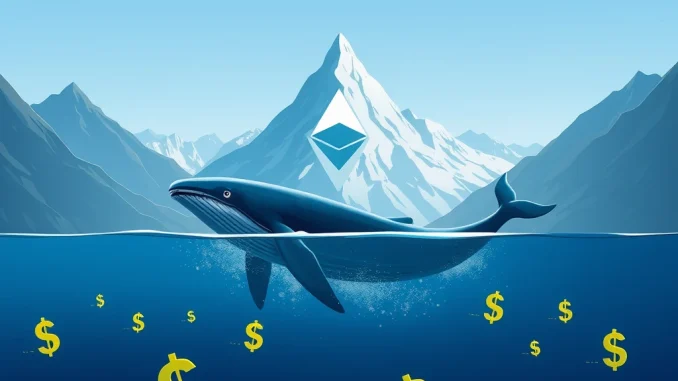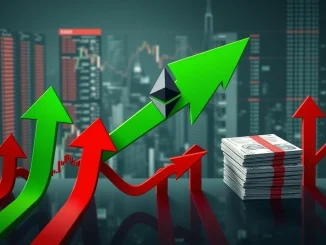
The world of cryptocurrency is filled with tales of fortunes made and opportunities missed. Recently, a significant event unfolded involving an ETH whale, capturing the attention of the crypto community. This wasn’t just any transaction; it was a strategic move by a major holder of Ethereum, revealing the complexities and sometimes heartbreaking realities of crypto trading. Let’s delve into the details of this fascinating case and uncover the lessons it holds for every crypto enthusiast and investor.
Who are ETH Whales and Why Do Their Moves Matter?
In the cryptocurrency ecosystem, ‘whales’ are individuals or entities that hold substantial amounts of a particular cryptocurrency. Their transactions can significantly influence market dynamics due to the sheer volume they trade. An Ethereum whale, specifically, holds large amounts of ETH, the native cryptocurrency of the Ethereum network. When an ETH whale makes a move, especially a large sale, it can send ripples across the market, impacting prices and investor sentiment.
Why should you care about what Ethereum whales are doing? Here’s why:
- Market Influence: Whale transactions can lead to price volatility. Large sell-offs can trigger price drops, while significant buys can push prices up.
- Market Sentiment Indicator: Whale behavior can offer insights into market sentiment. Are they accumulating or distributing? These actions can signal broader market trends.
- Potential Opportunities & Risks: Tracking whale movements can help traders identify potential entry and exit points in the market. However, it’s crucial to remember that following whales blindly can be risky.
The Tale of the 900-Day ETH Whale: A Strategic Sell or a Missed Opportunity?
Now, let’s focus on the specific ETH whale transaction that’s making headlines. This particular whale held a massive 10,000 ETH for an impressive 900 days – that’s roughly two and a half years! According to data from Lookonchain, a blockchain analytics platform, this whale finally decided to liquidate their entire stake on April 8th. Let’s break down the key numbers:
| Metric | Value |
|---|---|
| ETH Held | 10,000 ETH |
| Holding Period | Over 900 days |
| Purchase Date (Approx.) | Late 2022 |
| Purchase Cost | $12.95 million |
| Sale Date | April 8th |
| Sale Proceeds | $15.71 million |
| Profit | $2.75 million |
| Missed Peak Gain | $27.6 million |
As you can see, the ETH whale made a substantial profit of $2.75 million. Buying ETH for $12.95 million and selling for $15.71 million is undoubtedly a successful trade in many contexts. However, the story takes a dramatic turn when we consider the ‘missed peak gain’.
The Heartbreak of Missed Gains: A $27.6 Million What-If Scenario
The cryptocurrency market is known for its extreme volatility. Ethereum, in particular, has seen incredible price swings over the years. During the period this whale held their ETH, Ethereum reached a peak price of over $4,000. Had the whale sold at this peak, their 10,000 ETH stake would have been worth a staggering $43.31 million! Instead, they sold for $15.71 million, leaving a potential missed gain of $27.6 million on the table. This figure is truly eye-watering and highlights the inherent challenge of timing the market, even for seasoned Ethereum whale investors.
It’s important to understand that ‘missed gains’ are a common, albeit painful, part of investing. No one can perfectly predict market tops and bottoms consistently. In hindsight, it’s easy to say, “If only they had sold at the peak!” But in reality, making such decisions in real-time, amidst market noise and uncertainty, is incredibly difficult.
Why Did the Whale Sell and Miss Out on Potential Crypto Profit?
We can only speculate on the reasons behind the ETH whale’s selling decision. Here are a few possibilities:
- Profit Target Reached: Perhaps the whale had a predetermined profit target in mind. A $2.75 million profit might have been their goal, and they decided to secure it, regardless of potential future gains.
- Risk Management: After holding for 900 days, the whale might have felt that the risk of further holding outweighed the potential reward. Market conditions change, and perceived risk levels can increase.
- Alternative Investment Opportunities: The whale might have identified other investment opportunities that they deemed more attractive at that moment. Capital is often reallocated based on perceived best returns.
- Personal Circumstances: External factors and personal financial needs can also influence investment decisions. The whale might have needed to liquidate assets for reasons unrelated to market predictions.
- Market Correction Anticipation: It’s possible the whale anticipated a market correction and decided to sell to avoid potential losses, even if it meant missing out on further upside.
It’s crucial to remember that every investor has their own strategy, risk tolerance, and financial goals. What might seem like a missed gain to an outsider could be a perfectly rational and strategic move within the context of the whale’s overall investment plan.
Lessons Learned from the ETH Whale’s Transaction: Actionable Insights for Crypto Investors
This ETH whale story offers valuable lessons for anyone involved in cryptocurrency investing:
- Market Timing is Incredibly Difficult: Trying to perfectly time market tops and bottoms is a near-impossible task. Focus on long-term strategies rather than chasing short-term peaks.
- Profit is Still Profit: While missing potential peaks can be disappointing, securing a profit is always a positive outcome. Don’t let the pursuit of perfection overshadow actual gains.
- Have a Defined Strategy: Develop a clear investment strategy with defined entry and exit points, profit targets, and risk management rules. This helps in making rational decisions rather than emotional ones.
- Risk Management is Paramount: Always consider risk management. Diversification, stop-loss orders, and understanding your risk tolerance are crucial for long-term success in volatile markets.
- Focus on Long-Term Value: Instead of solely focusing on short-term price fluctuations, consider the long-term value and potential of the projects you invest in.
- Don’t Compare Your Trades to Others: Every investor’s situation is unique. Comparing your trades to others, especially whales, can lead to emotional decision-making and regret.
The Emotional Rollercoaster of Crypto Trading: Balancing Greed and Fear
The cryptocurrency market is often described as an emotional rollercoaster. The potential for rapid gains can fuel greed, while the risk of sudden crashes can trigger fear. The story of this ETH whale perfectly illustrates this emotional dynamic. The allure of potentially massive profits (greed) might have kept the whale holding for 900 days, but eventually, the fear of a market downturn or the desire to secure existing profits (fear) led to the sale.
Successful crypto investing requires emotional discipline. It’s about making rational decisions based on strategy and analysis, rather than being swayed by market hype or fear-mongering. Understanding your own emotional biases and developing strategies to mitigate them is a critical skill for navigating the crypto markets.
Conclusion: Embracing Crypto Profit and Learning from Every Trade
The ETH whale’s transaction, while seemingly a missed gains scenario, serves as a powerful reminder of the realities of cryptocurrency trading. It underscores the difficulty of perfect market timing, the importance of having a solid strategy, and the need for emotional discipline. While the whale might have left millions on the table in potential profits, they still secured a significant crypto profit of $2.75 million. In the volatile world of crypto, securing profits and learning from every trade, whether it’s a massive whale transaction or a smaller retail investment, is the key to long-term success. This tale encourages us to focus on strategic investing, realistic expectations, and continuous learning in the exciting yet unpredictable world of cryptocurrencies.



